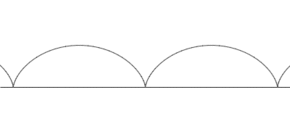Trochoid


Trochoid derives from the Greek word for wheel, "trokhos". In these sense, the word "trochoid" was coined by Gilles de Roberval for the curve described by a fixed point as a circle rolls along a straight line. As a circle of radius a rolls without slipping along a line L, the center C moves parallel to L, and every other point P in the rotating plane rigidly attached to the circle traces the curve called the trochoid. Let CP = b. If P lies inside the circle (b < a), on its circumference (b = a), or outside (b > a), the trochoid is described as being curtate, common, or prolate, respectively. Parametric equations of the trochoid, which assume L is the x-axis, are
where θ is the variable angle through which the circle rolls. A curtate trochoid is traced by a pedal when a bicycle is pedaled along a straight line. A prolate, or extended trochoid is traced by the tip of a paddle when a boat is driven with constant velocity by paddle wheels; this curve contains loops. A common trochoid, also called a cycloid, has cusps at the points where P touches the L.
A more general approach would define a trochoid as the locus of a point  orbiting at a constant rate around an axis located at
orbiting at a constant rate around an axis located at  ,
,
which axis is being translated in the x-y-plane at a constant rate in either a straight line,
or a circular path (another orbit) around  (the hypotrochoid/epitrochoid case),
(the hypotrochoid/epitrochoid case),
The ratio of the rates of motion and whether the moving axis translates in a straight or circular path determines the shape of the trochoid. In the case of a straight path, one full rotation coincides with one period of a periodic (repeating) locus. In the case of a circular path for the moving axis, the locus is periodic only if the ratio of these angular motions,  , is a rational number, say
, is a rational number, say  , where
, where  &
&  are coprime, in which case, one period consists of
are coprime, in which case, one period consists of  orbits around the moving axis and
orbits around the moving axis and  orbits of the moving axis around the point
orbits of the moving axis around the point  . The special cases of the epicycloid and hypocycloid, generated by tracing the locus of a point on the perimeter of a circle of radius
. The special cases of the epicycloid and hypocycloid, generated by tracing the locus of a point on the perimeter of a circle of radius  while it is rolled on the perimeter of a stationary circle of radius
while it is rolled on the perimeter of a stationary circle of radius  , have the following properties:
, have the following properties:
where  is the radius of the orbit of the moving axis. The number of cusps given above also hold true for any epitrochoid and hypotrochoid, with "cusps" replaced by either "radial maxima" or "radial minima."
is the radius of the orbit of the moving axis. The number of cusps given above also hold true for any epitrochoid and hypotrochoid, with "cusps" replaced by either "radial maxima" or "radial minima."
See also
External links
- http://www.xahlee.org/SpecialPlaneCurves_dir/Trochoid_dir/trochoid.html
- Weisstein, Eric W., "Trochoid", MathWorld.
- Online experiments with the Trochoid using JSXGraph





